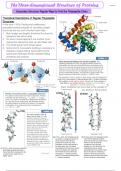Summary
Summary The Three-dimensional Structure of Proteins
- Course
- Institution
- Book
These notes are a comprehensive summary of chapter 6: The 3-D Structure of Proteins. The topics include: The Secondary Structure: Regular Ways to Fold the Polypeptide Chain. Fibrous Proteins: Structural Materials of Cells and Tissues. Globular Proteins: Tertiary Structure and Functional Diversit...
[Show more]





